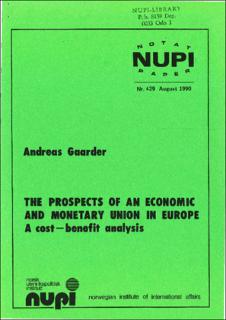| dc.contributor.author | Gaarder, Andreas | |
| dc.coverage.spatial | Europe | en_US |
| dc.date.accessioned | 2022-09-13T12:01:29Z | |
| dc.date.available | 2022-09-13T12:01:29Z | |
| dc.date.issued | 1990-08 | |
| dc.identifier.issn | 0800-0018 | |
| dc.identifier.uri | https://hdl.handle.net/11250/3017531 | |
| dc.description.abstract | The Delors report (April 1989) took the aim of an Economic and Monetary Union (EMU) as given and only outlined a strategy in order to achieve this goal. In spite of the fact that the EC countries have committed themselves to the creation of an EMU, : none of the treaties signed in this respect has clearly defined precisely which features an EMU should consist of. Thus, since the costs and benefits will vary according to which definition you give of an EMU, the final decision on the features of the EMU to be adopted will depend on a political economy analysis of the costs and benefits expected to result from the establishment of such a Union. Accordingly, this paper first sets out to find an a priori definition of EMU upon which a cost-benefit analysis may be based. Since the concept of "EMU" is no novelty in the context of European integration a short history of the European Monetary Integration is given. Given the positive achievements of the EMS, the question is asked "why is there a need for further monetary integration?". The paper then outlines the different arguments that have been put forward during the debate since the Delors report was published. On the basis of a definition of EMU that is arrived at by recognising the necessary and sufficient conditions for the stable functioning of such a Union in a long-term perspective, a political economy cost benefit analysis is performed with the aim of giving a qualitative assessment of the prospects of an EMU, and more precisely what the features of the Union are likely to be. This analysis takes-into account that there are some gains and losses that are more general in character, i.e. affecting the whole of the EC in a more or less equal way, and that there are some gains and losses that will affect countries differently, i.e. creating relative distortions between the countries in the net gains (or losses) that occur through the completion of EMU. | en_US |
| dc.language.iso | eng | en_US |
| dc.publisher | NUPI | en_US |
| dc.relation.ispartofseries | NUPI notat;429 | |
| dc.rights | Navngivelse-Ikkekommersiell-DelPåSammeVilkår 4.0 Internasjonal | * |
| dc.rights.uri | http://creativecommons.org/licenses/by-nc-sa/4.0/deed.no | * |
| dc.subject | Economic integration | en_US |
| dc.subject | Money | en_US |
| dc.subject | History | en_US |
| dc.subject | EEC | en_US |
| dc.subject | EMS | en_US |
| dc.title | The Prospects of an Economic and Monetary Union in Europe : A cost—benefit analysis | en_US |
| dc.type | Report | en_US |
| dc.description.version | publishedVersion | en_US |
| dc.rights.holder | NUPI | en_US |
| dc.subject.nsi | VDP::Samfunnsvitenskap: 200::Statsvitenskap og organisasjonsteori: 240::Internasjonal politikk: 243 | en_US |

